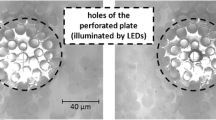Abstract
Curing process and rheological behaviors of a monocomposant epoxy resin used in structural aeronautic applications are investigated. This study helped settle the basic parameters in order to optimize the infusion process of carbon fibers in an epoxy matrix. The effect of carbon nanotube dispersion during the preinjection step is also studied to improve electrical behavior of composite parts. The curing process has been analyzed at isothermal temperature using differential scanning calorimetry technique. Viscosity measurements were achieved with a Couette geometry, suitable for low viscosity resin. A shear-thinning effect caused by adding CNTs in the epoxy matrix is detected. It is more pronounced at high temperature for increasing CNT mass content.








Similar content being viewed by others
References
Wang S, Chung DDL. Interlaminar interface in carbon fiber polymer-matrix. Compos Interfaces. 1998;6:497–505.
Iijima S. Helical microtubules of graphitic carbon. Nature. 1991;354:56–8.
Lonjon A, Demont P, Dantras E, Lacabanne C. Electrical conductivity improvement of aeronautical carbon fiber reinforced polyepoxy composites by insertion of carbon nanotubes. J Non-Cryst Solids. 2012;358:1859–62 Elsevier B.V.
Bauhofer W, Kovacs JZ. A review and analysis of electrical percolation in carbon nanotube polymer composites. Compos Sci Technol. 2009;69:1486–98 Elsevier Ltd.
Lux F. Review models proposed to explain the electrical conductivity of mixtures made of conductive and insulating materials. J Mater. 1993;28:285–301.
Barrau S, Demont P, Peigney A. DC and AC conductivity of carbon nanotubes-polyepoxy composites. Macromolecules. 2003;36:5187–94.
Gojny FH, Wichmann MHG, Fiedler B, Bauhofer W, Schulte K. Influence of nano-modification on the mechanical and electrical properties of conventional fibre-reinforced composites. Compos Part A Appl Sci Manuf. 2005;36:1525–35.
Qiu J, Zhang C, Wang B, Liang R. Carbon nanotube integrated multifunctional multiscale composites. Nanotechnology. 2007;18:275708.
Zeng X, Yu S, Sun R. Effect of functionalized multiwall carbon nanotubes on the curing kinetics and reaction mechanism of bismaleimide–triazine. J Therm Anal Calorim. 2013;114:387–95 Springer Netherlands.
Gude MR, Prolongo SG, Ureña A. Effect of the epoxy/amine stoichiometry on the properties of carbon nanotube/epoxy composites. J Therm Anal Calorim. 2012;108:717–23 Springer Netherlands.
Schulz SC, Faiella G, Buschhorn ST, Prado LASA, Giordano M, Schulte K, et al. Combined electrical and rheological properties of shear induced multiwall carbon nanotube agglomerates in epoxy suspensions. Eur Polym J. 2011;47:2069–77 Elsevier Ltd.
Hexcel. HexFlow® RTM 6 Product Data [Internet]. http://www.hexcel.com/Resources/DataSheets/RTM-Data-Sheets/RTM6_global.pdf. Accessed 15 Apr 2014.
Skordos AA, Partridge IK. Determination of the degree of cure under dynamic and isothermal curing conditions with electrical impedance. J Polym Sci Part B Polym Phys. 2003;42:146–54.
Aduriz XA, Lupi C, Boyard N, Bailleul J-L, Leduc D, Sobotka V, et al. Quantitative control of RTM6 epoxy resin polymerisation by optical index determination. Compos Sci Technol. 2007;67:3196–201.
El Sawi I, Olivier PA, Demont P, Bougherara H. Investigation of the effect of double-walled carbon nanotubes on the curing reaction kinetics and shear flow of an epoxy resin. J Appl Polym Sci. 2012;126:358–66.
Karkanas PI, Partridge IK. Cure modeling and monitoring of epoxy/amine resin systems. I. Cure kinetics modeling. J Appl Polym Sci. 2000;77:1419–31.
Moosburger-Will J, Greisel M, Sause MGR, Horny R, Horn S. Influence of partial cross-linking degree on basic physical properties of RTM6 epoxy resin. J Appl Polym Sci. 2013;130:4339–46.
Mukherjee G. Evaluation of processing temperature in the production of fibre reinforced epoxy composites. J Therm Anal Calorim. 2012;108:947–50 Springer Netherlands.
Turi EA. Thermal characterization of polymeric materials. New York: Adcademic Press; 1997. p. 1396–418.
Pascault JP, Williams RJJ. Glass transition temperature versus conversion relationships for thermosetting polymers. J Polym Sci Part B Polym Phys. 1990;28:85–95 Wiley.
Kaelbe DH. Physical and chemical properties of cured resins. In: May CA, Tanaka Y, editors. Epoxy resins: chemistry and technology. New York: Marcel Dekker; 1973. p. 327–371.
Pascault J, Sautereau H, Verdu J, Williams R. Thermosetting polymers. Boca Raton: CRC Press; 2002.
Hutchinson JM. Interpretation of glass transition phenomena in the light of the strength-fragility concept. Polym Int. 1998;47:56–64.
Hutchinson JM. Physical aging of polymers. Prog Polym Sci. 1995;20:703–30.
Hutchinson JM, McCarthy D, Montserrat S, Cortés P. Enthalpy relaxation in a partially cured epoxy resin. J Polym Sci Part B Polym Phys. 1996;34:229–39 Wiley.
Odegard GM, Bandyopadhyay A. Physical aging of epoxy polymers and their composites. J Polym Sci Part B Polym Phys. 2011;49:1695–716 Wiley.
Fogel M, Parlevliet P, Geistbeck M, Olivier P, Dantras E. Thermal, rheological and electrical characterization of MWCNTs/epoxy matrices for an innovative spray process. Compos Sci Technol (Under revision).
Rahatekar SS, Koziol KKK, Butler SA, Elliott JA, Shaffer MSP, Mackley, et al. Optical microstructure and viscosity enhancement for an epoxy resin matrix containing multiwall carbon nanotubes. J Rheol. 2006;50:599 N. Y. N. Y.
Ma A, Chinesta F, Mackley M. The rheology and modeling of chemically treated carbon nanotubes suspensions. J Rheol. 2009;53:547 N. Y. N. Y.
Author information
Authors and Affiliations
Corresponding author
Rights and permissions
About this article
Cite this article
Causse, N., Benchimol, S., Martineau, L. et al. Polymerization study and rheological behavior of a RTM6 epoxy resin system during preprocessing step. J Therm Anal Calorim 119, 329–336 (2015). https://doi.org/10.1007/s10973-014-4147-y
Received:
Accepted:
Published:
Issue Date:
DOI: https://doi.org/10.1007/s10973-014-4147-y




